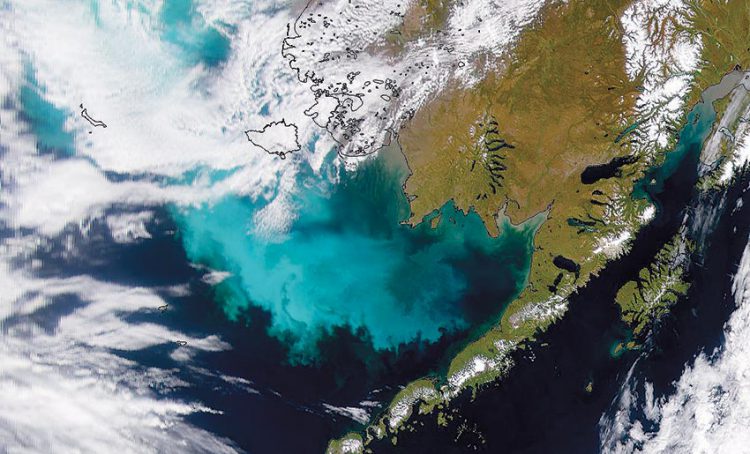Alaska Sea Grant and the Alaska Ocean Observing System recently cosponsored a two-day workshop to develop an action plan for harmful algal bloom (HAB) monitoring, event response, outreach, and research in Alaska.
NCCOS staff opened the workshop by providing a national perspective on HABs that set the stage for discussions of existing activities and identified additional needs for monitoring, research, response, and communication. NCCOS scientists also presented research updates on: (1) the development of the paralytic shellfish poisoning risk assessment tool, (2) the development of a rapid saxitoxin field detection kit funded by the North Pacific Research Board, and (3) data acquired jointly with AOOS.

Satellite image of Bering Sea algal bloom. Provided by the SeaWiFS Project, NASA/Goddard Space Flight Center, and ORBIMAGE.
The first day engaged a broad audience, including resource managers, shellfish growers, researchers, and anyone affected or interested in HABs and included presentations to provide an overview and summary of HAB-related activities around Alaska, as well as breakout groups to develop an action plan related to monitoring and event response. The second day was focused on a target audience interested in developing an action plan for HAB research, data sharing, outreach, and education.
There was broad agreement on the need to continue to improve state-wide coordination on HAB monitoring and event response. Specific issues of concern to NCCOS included: building on lessons learned from regional pytoplankton monitoring efforts, especially from current programs in Kachemak Bay and Southeast Alaska; improving the sharing of toxin testing results between federal, state and tribal labs; possibly expanding on the SoundToxins website; improving access to toxin testing capabilities especially for remote communities; and improving an understanding of how HABs impact higher trophic levels including marine mammal and seabird mortality events.
For more information, contact Kris Holderied or Marc Suddleson.
 Official websites use .gov
A .gov website belongs to an official government organization in the United States.
Official websites use .gov
A .gov website belongs to an official government organization in the United States. Secure .gov websites use HTTPS
A lock or https:// means you’ve safely connected to the .gov website. Share sensitive information only on official, secure websites.
Secure .gov websites use HTTPS
A lock or https:// means you’ve safely connected to the .gov website. Share sensitive information only on official, secure websites.